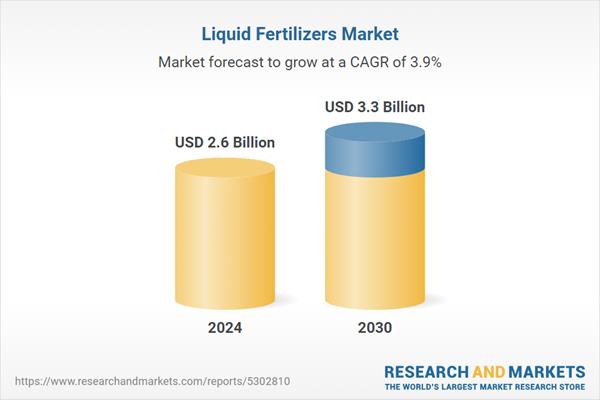The global market for Liquid Fertilizers was valued at US$2.6 Billion in 2024 and is projected to reach US$3.3 Billion by 2030, growing at a CAGR of 3.9% from 2024 to 2030. This comprehensive report provides an in-depth analysis of market trends, drivers, and forecasts, helping you make informed business decisions. The report includes the most recent global tariff developments and how they impact the Liquid Fertilizers market.
Segments: Crop Type (Cereals & Grains, Fruits & Vegetables, Oilseeds & Pulses, Other Crop Types); Type (Nitrogen, Phosphorus, Potash, Micronutrients); Application (Foliar, Fertigation, Soil, Other Applications).
Geographic Regions/Countries: World; United States; Canada; Japan; China; Europe (France; Germany; Italy; United Kingdom; Spain; Russia; and Rest of Europe); Asia-Pacific (Australia; India; South Korea; and Rest of Asia-Pacific); Latin America (Argentina; Brazil; Mexico; and Rest of Latin America); Middle East (Iran; Israel; Saudi Arabia; United Arab Emirates; and Rest of Middle East); and Africa.
The analysts continuously track trade developments worldwide, drawing insights from leading global economists and over 200 industry and policy institutions, including think tanks, trade organizations, and national economic advisory bodies. This intelligence is integrated into forecasting models to provide timely, data-driven analysis of emerging risks and opportunities.
Global Liquid Fertilizers Market - Key Trends and Drivers Summarized
How Are Liquid Fertilizers Revolutionizing Modern Agriculture?
Liquid fertilizers are becoming increasingly popular in modern agriculture due to their ease of application, rapid nutrient uptake, and ability to deliver essential nutrients directly to the roots of plants. Unlike traditional solid fertilizers, liquid fertilizers are applied in a dissolved form, which allows for more precise control over nutrient distribution and minimizes nutrient loss through runoff. They are commonly used in both large-scale farming and small horticultural operations to improve crop yields and promote healthy plant growth. With the global population continuing to rise, liquid fertilizers are playing a crucial role in ensuring sustainable and efficient food production.What Innovations Are Shaping the Liquid Fertilizer Market?
The liquid fertilizer market is evolving with innovations in formulation and delivery systems. New liquid fertilizers are being developed with controlled-release properties, ensuring that plants receive a steady supply of nutrients over time. Micronutrient-enriched liquid fertilizers are gaining popularity as they address specific nutrient deficiencies in the soil, promoting healthier and more resilient crops. The integration of liquid fertilizers with precision farming technologies, such as drip irrigation and foliar feeding systems, is also improving the efficiency of nutrient delivery. Additionally, environmentally friendly formulations, such as organic and bio-based liquid fertilizers, are emerging as sustainable alternatives to traditional chemical fertilizers.How Do Market Segments Define the Growth of Liquid Fertilizers?
Nutrient types include nitrogen, phosphorous, potassium (NPK) fertilizers, and micronutrients, with NPK fertilizers representing the largest segment as they provide essential macronutrients for plant growth. Crop types include cereals, fruits, vegetables, and oilseeds, with cereals being the largest market segment due to the widespread use of liquid fertilizers in large-scale grain farming. Application methods include fertigation, foliar spray, and soil injection, with fertigation leading the market as it allows for the precise application of liquid fertilizers through irrigation systems.What Factors Are Driving the Growth in the Liquid Fertilizer Market?
The growth in the liquid fertilizer market is driven by several factors, including the increasing demand for high-efficiency fertilizers, the adoption of precision agriculture, and the need to improve crop yields in a growing global population. Farmers are seeking more effective ways to manage nutrient levels in their fields, and liquid fertilizers offer the advantage of faster nutrient uptake and better application control. Precision agriculture technologies, such as GPS-guided application systems, are enabling more targeted use of liquid fertilizers, reducing waste and improving environmental sustainability. Additionally, the shift toward sustainable farming practices is encouraging the use of bio-based and organic liquid fertilizers, further supporting market growth.Report Scope
The report analyzes the Liquid Fertilizers market, presented in terms of units. The analysis covers the key segments and geographic regions outlined below.Segments: Crop Type (Cereals & Grains, Fruits & Vegetables, Oilseeds & Pulses, Other Crop Types); Type (Nitrogen, Phosphorus, Potash, Micronutrients); Application (Foliar, Fertigation, Soil, Other Applications).
Geographic Regions/Countries: World; United States; Canada; Japan; China; Europe (France; Germany; Italy; United Kingdom; Spain; Russia; and Rest of Europe); Asia-Pacific (Australia; India; South Korea; and Rest of Asia-Pacific); Latin America (Argentina; Brazil; Mexico; and Rest of Latin America); Middle East (Iran; Israel; Saudi Arabia; United Arab Emirates; and Rest of Middle East); and Africa.
Key Insights:
- Market Growth: Understand the significant growth trajectory of the Cereals & Grains segment, which is expected to reach US$1.4 Billion by 2030 with a CAGR of a 3.6%. The Fruits & Vegetables segment is also set to grow at 4.6% CAGR over the analysis period.
- Regional Analysis: Gain insights into the U.S. market, valued at $706.3 Million in 2024, and China, forecasted to grow at an impressive 6.5% CAGR to reach $677.5 Million by 2030. Discover growth trends in other key regions, including Japan, Canada, Germany, and the Asia-Pacific.
Why You Should Buy This Report:
- Detailed Market Analysis: Access a thorough analysis of the Global Liquid Fertilizers Market, covering all major geographic regions and market segments.
- Competitive Insights: Get an overview of the competitive landscape, including the market presence of major players across different geographies.
- Future Trends and Drivers: Understand the key trends and drivers shaping the future of the Global Liquid Fertilizers Market.
- Actionable Insights: Benefit from actionable insights that can help you identify new revenue opportunities and make strategic business decisions.
Key Questions Answered:
- How is the Global Liquid Fertilizers Market expected to evolve by 2030?
- What are the main drivers and restraints affecting the market?
- Which market segments will grow the most over the forecast period?
- How will market shares for different regions and segments change by 2030?
- Who are the leading players in the market, and what are their prospects?
Report Features:
- Comprehensive Market Data: Independent analysis of annual sales and market forecasts in US$ Million from 2024 to 2030.
- In-Depth Regional Analysis: Detailed insights into key markets, including the U.S., China, Japan, Canada, Europe, Asia-Pacific, Latin America, Middle East, and Africa.
- Company Profiles: Coverage of players such as AgroLiquid AD, Agrotiger, Compo Expert GmbH, FoxFar Soil & Fertilizer Company, Haifa Chemicals Ltd and more.
- Complimentary Updates: Receive free report updates for one year to keep you informed of the latest market developments.
Some of the 39 companies featured in this Liquid Fertilizers market report include:
- AgroLiquid AD
- Agrotiger
- Compo Expert GmbH
- FoxFar Soil & Fertilizer Company
- Haifa Chemicals Ltd
- ICL Fertilizers
- K+S Aktiengesellschaft
- Kugler Company
- Nutra Flow
- Nutrien Ltd.
- Nutri-Tech Solutions
- Plant Food Company Inc.
- Tessenderlo Group
- Yara International ASA
Tariff Impact Analysis: Key Insights for 2025
Global tariff negotiations across 180+ countries are reshaping supply chains, costs, and competitiveness. This report reflects the latest developments as of April 2025 and incorporates forward-looking insights into the market outlook.The analysts continuously track trade developments worldwide, drawing insights from leading global economists and over 200 industry and policy institutions, including think tanks, trade organizations, and national economic advisory bodies. This intelligence is integrated into forecasting models to provide timely, data-driven analysis of emerging risks and opportunities.
What’s Included in This Edition:
- Tariff-adjusted market forecasts by region and segment
- Analysis of cost and supply chain implications by sourcing and trade exposure
- Strategic insights into geographic shifts
Buyers receive a free July 2025 update with:
- Finalized tariff impacts and new trade agreement effects
- Updated projections reflecting global sourcing and cost shifts
- Expanded country-specific coverage across the industry
Table of Contents
I. METHODOLOGYII. EXECUTIVE SUMMARY2. FOCUS ON SELECT PLAYERSIII. MARKET ANALYSISCANADAITALYSPAINRUSSIAREST OF EUROPESOUTH KOREAREST OF ASIA-PACIFICARGENTINABRAZILMEXICOREST OF LATIN AMERICAIRANISRAELSAUDI ARABIAUNITED ARAB EMIRATESREST OF MIDDLE EASTIV. COMPETITION
1. MARKET OVERVIEW
3. MARKET TRENDS & DRIVERS
4. GLOBAL MARKET PERSPECTIVE
UNITED STATES
JAPAN
CHINA
EUROPE
FRANCE
GERMANY
UNITED KINGDOM
ASIA-PACIFIC
AUSTRALIA
INDIA
LATIN AMERICA
MIDDLE EAST
AFRICA
Table Information
| Report Attribute | Details |
|---|---|
| No. of Pages | 92 |
| Published | April 2025 |
| Forecast Period | 2024 - 2030 |
| Estimated Market Value ( USD | $ 2.6 Billion |
| Forecasted Market Value ( USD | $ 3.3 Billion |
| Compound Annual Growth Rate | 3.9% |
| Regions Covered | Global |









